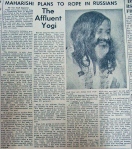In February of 1968 the Beatles and their spouses finally arrived in Rishikesh to begin their meditation program. Many international media organizations dispatched correspondents to gather whatever details they could regarding the goings-on inside the Maharishi’s private compound. Sample a BBC Pathé report from Rishikesh below:
[youtube:http://www.youtube.com/watch?v=86SnHEcAxrM%5D
. . .
Not to be outdone, newspapers such as the Times of India, The Hindusthan Times, The Statesman, and The Hindusthan Standard sent their own reporters in order to gain some inside knowledge of the Beatles’ activities in Rishikesh. Members of the press were rarely permitted access inside the Maharishi’s ashram. However, the Beatles and the Maharishi occasionally offered press statements, particularly following a Beatle departure (Ringo Starr returned to England after two weeks, while Paul McCartney departed Rishikesh after one month. Harrison and John Lennon remained in Rishikesh until April.)
Saeed Naqvi of The Statesman noted in retrospect: “The reception [a reporter] got at the ashram depended on the Maharishi’s moods. ‘He has not liked your write-up today,’ someone would say and one knew the going would be difficult.”
. . .
In March, a group of Indian parliamentarians charged that Rishikesh had become a “hot-bed of espionage,” indicting the Maharishi and his disciples directly. K. Anirudham and other parliamentarians affiliated with the Communist Party of India (Marxist) demanded a “thorough inquiry” into the activities of the Maharishi and his foreign followers at Rishikesh. This episode and others reveal the ambivalence with which the Maharishi was received in his home country, and the unease his growing influence provoked in certain quarters. Additionally, it reveals the extent to which certain Indian political factions felt they could capitalize on this unease:
In the wake of these allegations, a separate group of Indian parliamentarians met with the Maharishi in an apparent attempt to quell public fears regarding any links between the Maharishi and foreign spies. In a statement, the MPs declared that “no public harm” had come as a result of the Maharishi’s “reinterpretation of Indian philosophy abroad,” while describing his ashram as “properly run and well-maintained:”
. . .
Communist politicians were not the only voices in opposition to the Maharishi and his associates. The same month, security was increased at the ashram as “rival sadhus” expressed increasing hostility toward the Maharishi. In the absence of substantive explanation, we can only speculate regarding the sadhus’ motivations, but we may infer that their concerns may not have been solely motivated by ideology and/or inter-sadhu economic rivalry: during the same period, local politicians expressed opposition to the Maharishi’s plans to construct an airfield at his Rishikesh ashram, wishing instead to allot the territory to the “landless kisans [agricultural peoples] of Kumaun:”
Throughout the first half of 1968, newspapers from across India featured a number of articles concerning the Maharishi’s growing influence in India and abroad:































